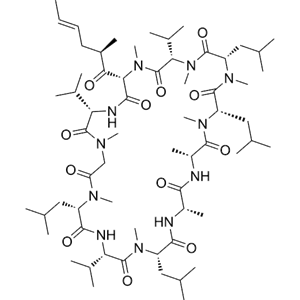All AbMole products are for research use only, cannot be used for human consumption.

In vitro: Valspodar (PSC 833) has no cytotoxicity effects at up to the concentration of 0.75 μg/mL. Valspodar (0.25, 0.5 and 0.75 μg/mL) and DOX-L are added to the DOX resistant cells, and cell kill efficacy of MDR cell type increases significantly when valspodar is administered alongside DOX-L. Valspodar (0.5 and 0.75 μg/mL), in combination with all concentrations of DOX, are most toxic and kill more than 70% of the resistant cells. Pretreatment with PSC833 decreases the IC50 value of mitoxantrone in MDA-MB-435mdr cells to 0.4±0.02 μM in MDR cells and almost completely reverses the resistance of MDR cells to mitoxantrone.
In vivo: valspodar (10 mg/kg, o.p.) exhibits minimal blood-cell partitioning as reflected in its low mean blood-to-plasma ratio of approximately 0.52. Valspodar displays properties of slow clearance and a large volume of distribution. Valspodar shows properties of low hepatic extraction and wide distribution, similar to that of its structural analogue cyclosporine A. Preadministration of PSC833 to mice increases mitoxantrone fluorescent intensity in MDR tumor to 94% of that in the wild-type tumors.
| Cell Experiment | |
|---|---|
| Cell lines | T47D/TAMR-6 cells |
| Preparation method | After 48 hours incubation, fresh medium containing serial concentration of various drug formulations, including free DOX, DOX-L, mixture of DOX-L and free Valspodar (PSC 833), mixture of DOX-L and PSC-L and DOX/PSC-L are added. The plates are then incubated for an additional 48 hours before washing with normal saline followed by adding MTT solution (0.5 mg/mL) to each well, and incubated for 4 h at 37°C. |
| Concentrations | 0.5 mg/mL |
| Incubation time | 48 h |
| Animal Experiment | |
|---|---|
| Animal models | Male Sprague–Dawley rats |
| Formulation | saline |
| Dosages | 10 mg/kg |
| Administration | orally |
| Molecular Weight | 1214.62 |
| Formula | C63H111N11O12 |
| CAS Number | 121584-18-7 |
| Solubility (25°C) | DMSO 90 mg/mL |
| Storage |
Powder -20°C 3 years ; 4°C 2 years In solvent -80°C 6 months ; -20°C 1 month |
| Related P-glycoprotein Products |
|---|
| Zosuquidar
Zosuquidar (LY335979) is a P-glycoprotein (P-gp) inhibitor (Ki=59 nM). |
| Tariquidar dimesylate
Tariquidar dimesylate (XR9576 dimesylate) is a P-glycoprotein (P-gp) inhibitor. |
| Tariquidar dihydrochloride
Tariquidar dihydrochloride (XR9576 dihydrochloride) is a potent and specific inhibitor of P-glycoprotein (P-gp) with the high affinity (Kd=5.1 nM). |
| Reversin 121
Reversin 121 is a P-glycoprotein inhibitor. |
| Reversin 205
Reversin 205 ([Boc-Glu(Obzl)]2-Lys-Ome) is a P-glycoprotein (ABCB1) inhibitor. |
All AbMole products are for research use only, cannot be used for human consumption or veterinary use. We do not provide products or services to individuals. Please comply with the intended use and do not use AbMole products for any other purpose.


Products are for research use only. Not for human use. We do not sell to patients.
© Copyright 2010-2024 AbMole BioScience. All Rights Reserved.
